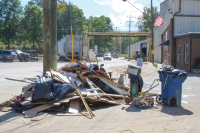Swain seeks more input on road regulations
By Julia Merchant • Staff Writer
Contractors, Realtors and graders in Swain County claim they need more time to comment on an ordinance that would regulate the slope and width of mountainside roads.
County commissioners, who have already held two public hearings on the ordinance, agreed last week to hold a third one.
At the county’s most recent public hearing on July 23, which attracted more than 30 people, only two citizens had signed up to speak. Due to the large turnout, commissioners decided to modify the public hearing rules and let all in attendance speak.
Turns out, the crowd — which consisted of Realtors, excavators, the county planning board, and the county attorney, among others — had plenty to say. Concerns were raised that the Swain County Planning Board had not promoted its meetings to the general public when they were drafting the subdivision ordinances, and therefore lacked an appropriate level of public input at the outset.
“It was brought up by some of the developers and some of the guys who build the roads that even though the planning board had four or five public meetings, the developers weren’t aware that they were going on,” said Commissioner David Monteith.
Audience members that had seen the public notice of the planning board meeting printed in the newspaper (as required by state law) seemed not to be aware that the public could attend those meetings.
Citizens requested an additional two to three weeks to submit changes to the ordinances and asked for the possibility of a meeting with the planning board.
Commissioners agreed, and have given citizens three weeks to submit their comments to the county manager’s office.
County Manager Kevin King will then submit those comments to the planning board, at which point the planning board will schedule another public meeting. Then commissioners will present the newly revised ordinances in another public hearing.
The subdivision ordinances — which deal mainly with road widths and grades —are a significant step for Swain County as they are the first development regulations of any kind that have been proposed by commissioners. The commissioners have been trying to put development regulations together for the last seven or eight years, according to Monteith, and had discussed holding public meetings to talk about what smart growth could do for Swain County.
Monteith is excited to carry on the idea first formulated by the previous board.
“I think we need to do it wisely and to where it doesn’t harm our environment and our citizens that have lived here all their lives,” said Monteith. He also said it was important to get input from newcomers.
The proposed subdivision ordinances only cover a very specific area — roads. Commissioner Glenn Jones talked about the importance of working on development regulations in small increments.
“I’d like to see us get through this. If we’re going to do one, we want to do it right. We’re concentrating on the ordinance at hand. When we get loose ends tied together, it may be possible to look at something else,” he said.
Jones said a public meeting with the planning board is scheduled for Aug. 7.
Road proposal
Swain County’s first-ever development regulations primarily deal with road guidelines in private subdivisions.
Currently, there are no rules, criteria or oversight for roads being built in subdivisions. They can be as steep and narrow as a developer likes. Anyone with keys to a dozer can be hired to build the roads without regard for slope stability or engineering practices.
Highlights of the ordinance are:
• Road grades are capped at 20 percent, with an exception of up to 25 percent if certified by a professional engineer that no other feasible option exists.
• Portions of a road that exceed a 15 percent grade must be paved. Also, 300 feet on either end of the section that exceeds 15 percent must also be paved.
• The road grade in a switchback cannot exceed a 10 percent grade.
• The turning radius of curves must be 35 feet from the centerline. This means fire trucks won’t have to do a three-point turn to get through a curve.
• Dead-ends must have either a center turning radius of 35 feet, or accommodate and “T” or “Y” turn around.
• A road serving one to five homes must be 12 feet wide, a road serving 6 to 12 lots must be 16 feet wide.





